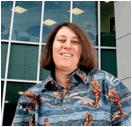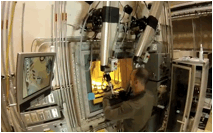 The solace of quantum
The solace of quantumEavesdropping on secret communications is about to get harder
A third project, organised by Jane Nordholt of Los Alamos National Laboratory, has just demonstrated how a pocket-sized QKD transmitter called the QKarD can securesignals sent over public data networks to control smart electricity grids. Smart grids balance demand and supply so that electricity can be distributed more efficiently. (full story)
 Schrödinger’s iPad? New Breakthroughs in Quantum Computing
Schrödinger’s iPad? New Breakthroughs in Quantum ComputingTwo developments in quantum computing in the past couple of weeks include government scientists at Los Alamos National Laboratory revealing that they developed a secure quantum computing network two years ago! (watch it here)
This story also appeared in Homeland Security Today
 Our Endangered Nuclear Weaponeers
Our Endangered Nuclear WeaponeersNo more nukes means no more experts, and their talents have kept us safe.
It takes a nuclear weaponeer to stop a nuclear weaponeer. And I should know.
In the 1990s, I designed nuclear bombs at Lawrence Livermore National Laboratory. In the 2000s at Los Alamos, I ran one of the largest programs to reduce thethreat of weapons of mass destruction, directing hundreds of professionals who had worked for decades on all aspects of nuclear weapons. The background, experience and judgment of these weaponeers were responsible for successfully mitigating and preventing various nuclear threats, details of which are still classified. (full story)
 Researchers Explain Magnetic Field Misbehavior in Solar Flares: The Culprit is Turbulence
Researchers Explain Magnetic Field Misbehavior in Solar Flares: The Culprit is TurbulenceWhen a solar flare filled with charged particles erupts from the sun, its magnetic fields sometime break a widely accepted rule of physics. The flux-freezing theorem dictates that the magnetic lines of force should flowaway in lock-step with the particles, whole and unbroken. Instead, the lines sometimes break apart and quickly reconnect in a way that has mystified astrophysicists.
But in a paper published in the May 23 issue of the journal Nature, an interdisciplinary research team led by a Johns Hopkins mathematical physicist says it has found a key to the mystery. The culprit, the group proposed, is turbulence -- the same sort of violent disorder that can jostle a passenger jet when it occurs in the atmosphere. Using complex computer modeling to mimic what happens to magnetic fields when they encounter turbulence within a solar flare, the researchersbuilt their case, explaining why the usual rule did not apply. (full story)
This story also appeared in Space Fellowship
 U.S. weapons-grade uranium shipments to Chalk River near end
U.S. weapons-grade uranium shipments to Chalk River near endThe U.S. National Nuclear Security Administration applied last week to Washington regulators for a new license to export seven kilograms of highly-enriched uranium (HEU) to Canada. Approval seems assured.
The HEU will be used as “target” material and irradiated in core of the NRU research reactor to produce six varieties of radioactive isotopes for life-saving nuclear medicine.
The U.S. has promising research underway too. The Los Alamos National Laboratory, for one, announced last week that for the first time, irradiated uranium fuel from has been recycled and reused for molybdenum-99 (Mo-99) production, with virtually no losses in Mo-99 yields or uranium recovery. Tc99m is a decay product of Mo-99. (full story)
 NASA Confirms That Curiosity Found An Ancient Martian Stream
NASA Confirms That Curiosity Found An Ancient Martian Stream Last year, NASA announced that the Curiosity rover had found preliminary evidence of an ancient streambed, indicating that water once flowed freely on Mars. After a few more months of study, that preliminary announcement has been confirmed – Curiosity has found the remains of an ancient stream.
Last year, NASA announced that the Curiosity rover had found preliminary evidence of an ancient streambed, indicating that water once flowed freely on Mars. After a few more months of study, that preliminary announcement has been confirmed – Curiosity has found the remains of an ancient stream.In addition, Curiosity’s ChemCam also took pictures of the rocks. ChemCam is a high powered laser that is used to blast tiny parts of the rock. The camera in ChemCam then captures the photons that are produced as a result. The spectra produced tell scientistswhat the chemical compositions of the rock are. (full story)
 Securing power grids from cyber attacks key to energy security
Securing power grids from cyber attacks key to energy security Securing power grids against cyber attacks is going to pose critical security challenge. Speaking to top US energy executives near Washington, Charles McMillan, director of the US Los Alamos National Laboratory, said, that securing the electrical grid is becoming more serious.
Securing power grids against cyber attacks is going to pose critical security challenge. Speaking to top US energy executives near Washington, Charles McMillan, director of the US Los Alamos National Laboratory, said, that securing the electrical grid is becoming more serious.Scientists are pretty pleased with the results so far, said Roger Wiens, a Los Alamos National Laboratory geochemist, who is among the international gaggle of researchers using Curiosity’s data to learn more about the Red Planet. Wiens will talk about Mars, the rover mission and what scientists have learned so far during a free talk Tuesday, May 14, at 7 p.m. at the James A. Little Theater in Santa Fe. (full story)
 Nuking Asteroids: Why One Scientist Wants To Blow Up Space Rocks [VIDEO]
Nuking Asteroids: Why One Scientist Wants To Blow Up Space Rocks [VIDEO]As the QE2 asteroid, a piece of rock nine times the size of a cruise ship, flies past Earth thisweek, one scientist has made headlines by suggesting we nuke asteroids that may be headed our way. (watch the video)
 Research Effort Deep Underground Could Sort Out Cosmic-Scale Mysteries
Research Effort Deep Underground Could Sort Out Cosmic-Scale MysteriesThe Department of Energy's Oak Ridge National Laboratory has begun delivery of germanium-76 detectors to an underground laboratory in South Dakota in a team research effort that might explain the puzzling imbalance between matter and antimatter generated by the Big Bang.
ORNL's partner institutions in the Majorana Demonstration Project are Black Hills State University, Duke University, Institute for Theoretical and Experimental Physics (Russia), Joint Institute for Nuclear Research (Russia), Los AlamosNational Laboratory, Lawrence Berkeley National Laboratory, North Carolina State University, Osaka (Japan) University, Pacific Northwest National Laboratory, South Dakota School of Mines and Technology, Triangle Universities Nuclear Laboratory, Centre for Particle Physics (Canada), University of Chicago, University of North Carolina, University of South Carolina, University of South Dakota, University of Tennessee and the Center for Experimental Nuclear Physics and Astrophysics. (full story)
To subscribe to Los Alamos Report, please send an email and include the words "subscribe losalamosreport" in the body of your email message; to unscubscribe, include "unsubscribe losalamosreport".
Please visit us at www.lanl.gov
And don't forget to follow us on Twitter, YouTube, Flickr and Facebook!








































